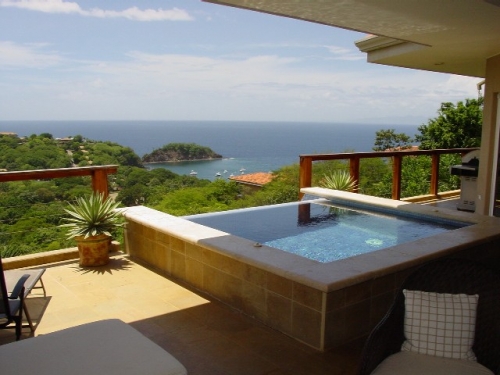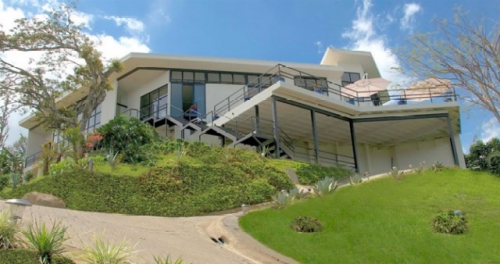Costa Rica Guide
Costa Rica Real Estate
List your property today!
Inclusion of real estate listings at Costa Rica Guide is
absolutely free of charge.
Featured Properties
Costa Rica Guide - Costa Rica Real Estate
Travel Information - Costa Rica Country Profile
Thinking about taking a holiday to see properties in Costa Rica?
Costa Rica has what you’re looking for ...
Tree-lined beaches whose warmth is exceeded only by the friendly people who live here, spectacular birds and flowers intensive colors rival those of an erupting volcano, activities ranging from whitewater rafting and surfing to sport fishing and golf, and more than a thousand lodging options to choose from, including everything from cozy bed-and-breakfast to luxury five-star hotels.
With so much variety, there’s guaranteed to be something to suit everyone’s taste!
Costa Rica is a small mountainous country on the narrow Central American isthmus. It’s only a day drive from northern border with Nicaragua to neighboring Panamá in the south, and one could cross from ocean to ocean in only a few hours. But why hurry? There’s just too much to see and do in between.
Costa Rica’s stunning scenic heritage unfolds in an ever-changing panorama of steaming volcanoes, forest mountains, dramatic skies and bucolic countryside. Dark lowland jungles give way to rolling savannas; Pacific surf crashes against rocky headlands, in sharp contrast to tranquility of palm-fringed Caribbean beaches.
The climate is idyllic. In the lowlands-which are dry in the Pacific northwest and humid elsewhere - daytime temperatures range in the eighties to nineties F° (high twenties to mid-thirties C°).
Usually in the seventies F° (low to mid-twenties C°) at middle elevation, the mercury can fall as low as the forties and fifties F° (five to mid-tens C°) at the top of the mountains. Even night time frost is not an uncommon occurrence on he highest peaks. Within each elevation range, temperatures remain relatively constant year-round.
Rainfall, on the other hand, is subject to annual and regional patterns.
The northwest has a fairly well-defined dry season ("verano" or summer) from November to April. The dry season is a month or two shorter along the southern Pacific coast. July also tends to be a dry month on the Pacific slope. Welcome rains during the balance of the year bring about a general greening and freshens the countryside.
Rains usually come afternoon cloudbursts, leaving the mornings sunny and the night sky filled with stars. This period is called "invierno" (Winter or rainy season) or "temporada verde" (green season). Rainfall on the Caribbean slope is more evenly distributed throughout the year, with marked dry period in May-June and again in September.
Each year, Costa Rica welcome thousands of visitors to share the peaceful beauty and natural treasures of their country.
In Costa Rica, tropical nature has reached its greatest expression.
Located in the tropical latitudes, between the giant biological influences of North and South America and bordered by two oceans, mountains Costa Rica enjoys an immense diversity of climates and environmental regions. Twelve major life zones harbor an astounding amount of plant and animal life.
While Costa Rica covers a mere 0.03% of the planet surface, the nation is endowed with over 5% of all life forms on earth.
Costa Ricans have preserved this invaluable biodiversity in protected areas covering fully one-quarter of the land and organized into major units called Conservation Areas. No other country in the word has much actively protected area per capita. Costa Rica is often cited as a model for conservation in harmony with community development and economic growth.
National Parks and reserves are open to the public at government established fees.
Private reserves set their own entrance rates.
An impressive 22,647 miles (36,447 km.) of roads plus well-developed nature trail systems easy access to every habitat and all but the most remote areas. You can drive to the very edge of a volcanic crater, through the heart of a mountain jungle, take an aerial tram ride in the rainforest canopy and soak up sun on a deserted beach, all on the same most remote areas.
Costa Rica’s nine active volcanoes vividly remind visitors of the awesome power contained in the earth’s thin mantle.
At Irazú Volcano, it is easy to see why Neil Armstrong said that its desolate landscape looks like the surface of the moon, sulfurous lake, is reminded just how tenuous is man’s supposed dominion over the word.
Arenal, the most active and no doubt the most studies of all of Costa Rica’s volcanoes, booms and rumbles with an unnerving consistency and nocturnal pyrotechnics have struck awe in hearts thousands of observers.
On the lower slopes of Rincón de la Vieja, power is vented in boiling mud pots, hissing fumaroles and thermal streams.
The non-volcanic Talamancas are ruggedly beautiful and contain two of nation’s tallest peaks. The Inter-American highway, crossing the 11,453 ft. (3,491 m) Cerro de la Muerte, reaches over 9,843 feet (3,000m), passing through highland forest of Costa Rican Oak and the only road-accessible "páramo" vegetation in the country. To see evidence of the glacier that topped 12,533 ft. (3,820 m.), Chirripó, during the last ice age, requires a 9 hours hike and cold-weather camping. But it’s definitely worth the effort.
The forest on the upper slopes of Costa Rica’s mountains and volcanoes are frequently draped in mist and clouds. Algae, mosses and lichens get a foothold on the constantly wet surfaces, providing a place of orchids, bromeliads, ferns and innumerable other plants to cling to.
So prolific is this "epiphytic" growth in the cloud forest that bare branches are virtually non-existent. Sometimes harsh conditions such as prevailing winds and supersaturated soils cause the forest to be stinted - like the elfin forest at Monteverde’s continental divide or the gnarly, dwarf woods at the summit of Poás Volcano. The cloud forest capture the imagination of even the most cynical among us. It emanates a sense of ancient and enduring life.
Of peace. Sitting quietly overhead, its long feathery tail swaying gently in breeze , is a scarlet and emerald bird that seems to embody the spirit of the cloud forest. Aptly named, the resplendent Quetzal is considered by many to be the most beautiful bird in the word.
In the foothills and lowlands of both slopes, Costa Rica’s rainforests harbor thousands of known life forms and thousands more yet to be described. They are among the last strongholds of biodiversity on earth. Resonating with the songs of birds, at dawn, the rainforest is quiet in the heat of the day, its stillness punctuated by the insect-like call of poison dart frogs, the rasping of cicadas or the whistled notes of wrens and ant birds.
The dark, cool interior of the primary rainforest is surprisingly free of entangling vegetation.
Only where light manages to filter through the interlocking canopy to the forest floor does vegetation proliferate. Walking in the rainforest is like taking a step back in time. The modern word and all its stress fade into insignificance.
For the most fulfilling experience in the forest, it is important to go with an experienced naturalist guide. These woods do not give up their secrets easily. Indeed, the uninitiated can be overwhelmed by such all-pervasive greenness. A naturalist will explain the complex inter-relationships of species in the forest, help you identify the birds, spot well-camouflaged creatures and, with luck, maybe even point out the tracks of those ever-elusive tapirs or jungle cats.
Of Costa Rica’s 850 bird species, visitors usually spot the big or colorful birds such as hawks, ducks, toucans and tanagers, plus noisy parrots and macaws. Monkeys, coatimundis, peccaries, agoutis, armadillos, sloths, deer, squirrels and bats are the most commonly seen mammals. Also frequently found are iguanas, crocodiles and various species of lizards.
During the sea turtle nesting season, lucky visitors can witness one nature’s ageless miracles, as these prehistoric looking creatures return to the same beach from which they were hatched to laboriously dig their nests and lay the eggs from which the next generation of turtles will emerge. Bizarre and colorful insects, vast numbers of flowering trees, shrubs and plants in every color of rainbow are part of an infinitely rewarding experience with tropical nature.
Those who venture beneath the seas, will find Costa Rica’s oceans teeming with fish and countless other creature of the deep. It is said that life in the sea rivals the biodiversity of rainforest.
No matter whether you are exploring the sea, the cloud forest, rainforest, mangroves or any other of Costa Rica’s many ecosystems, the most important things to take with you are curiosity, patience and realistic expectations. The natural word is not a zoo with defined times for animal viewing. Every sighting, from the industrious parasol ants to frolicking dolphins, to drowsy howler monkeys, is a very gift. Savor each one.
And if taste is more action-oriented, Costa Rica offers plenty of exciting alternatives.
Rafting on Costa Rica’s wild and scenic rivers is perhaps the single most popular adventure sport in the country. Expert outfitters and river guides, using internationally approved equipment, take thousands of beginners down the thrilling Class 111 water of the Reventazón River, every year. The more challenging Class IV.
Pacuare and the tricky Class V Pascua attract more experienced rafters. Swollen by green rains, rafting rivers are even better from May to November. Overnight trips are available.
Whitewater kayaking is a favorite sport and Costa Rica has hosted more than one international tournaments. Ocean kayaking is also rapidly gaining devotees because just about anyone can handle it after a few lessons.
Word champions have called Costa Rica’s Lake Arenal, at 1,350-1,800 ft. (450-600 m) above sea level, one of the globe’s top five windsurfing spots. Winds from, December to April blow steadily, carrying you along Arenal's 29 miles (42 km) surface, without changing either masts or sails. Just a couple of hours away is Puerto Soley, on the northern Pacific coast, for ocean windsurfing.
From anywhere in the country, the warm surf is only a few hours away. There are river mouth breaks, beach breaks, reef and, the experts say, one of the longest left hand curls in the word. Almost constant, manageable wave action means no long waits to hop on your board. There are lodges catering to surfers, 4-wheel-drive vehicles to access the most remote beaches - even charter airplanes to accommodate your board.
No wonder the surf magazines are targeting Costa Rica as a word surfing hot spot.
The northwest Pacific Coast offers scuba in a magnificent setting throughout the year, with more than 20 local dives sites, many in the gulf of Papagayo. Huge schools of fish are the norm and Jacks, Moray Eels, White-tipped Sharks, Eagle Rays and Puffer fish are commonly observed.
There are rock formations to be explore and visibility and in these warm waters ranges from 20 to 80 ft. (6 to 24 m.). beginners can take lessons from local, licensed instructors and a full range of first class equipment is available for rent. Caño Island, off the southwest coast, is know for huge schools of fish, rocky corals and undersea canyons. Experts will also want to make long ocean trip to Cocos Island, touted Jacques Cousteau as one of the finest deep water dive sites in the word.
Costa Rica rich marine life also means excellent sport fishing.
Along Pacific Coast, from the Gulf of Papagayo all way to Golfito, anglers find some of the best blue water and inshore fishing in the word. Annual catch & release billfish tournaments raise record numbers of sailfish and marlin. Roosterfish, Mahi-mahi-mahi, yellow-fin Tuna Grouper and Wahoo are among the common game fish. The Tortuguero Canals and the area around Barra del Colorado, both on Costa Rica’s northeast coast, have long been famous for fishing tarpon and snook.
Lake Arenal is the place to take a boat on quiet waters and hook the local " rainbow" bass". There’s also great trout fishing in Costa Rica’s mountain streams.
Day cruises to Tortuga Island, on the Gulf of Nicoya, are a highlight of many a Costa Rica vacation. Nature trips on lowland rivers are a relaxing way to see and view wildlife.
Even the most active adventurer or nature lover will want to smooth on an extra layer of SPF 15 (Solar Protection Factor 15) and spend some time on the beautiful beaches along Costa Rica’s more than 621 miles (1,000 km) of shoreline. Each has beauty and charter all its own, in every hue and texture. Many beaches are wild and undeveloped. At others, you’ll find cabins to rent or small hotels. For anyone preferring a resort atmosphere, there’s even a few of those, although in typical Costa Rican style, they are mostly small scale.
With its mountainous terrain and thousands of miles highways, byways and forest trails, Costa Rica is the ideal spot for mountain biking. Many hotels have equipment for rent and some local travel agencies offer organized tours.
Horseback riding in Costa Rica can take you along beaches, at the edge of country roads, through pastures and along forest trails.
Riding is great fun - one you get used to the different saddle, stirrups and neck rein steering. Although not strictly necessary, a little equestrian experience will stand you in good stead since ranch horse are usually rounded up for trail duty. Lessons on how to control your mount and special assistance should be requested (if it is not offered) before setting out on any trail ride.
Costa Rica’s National Parks are ideal for trekking, although you definitely need a guide if you plan to venture away from well-marked trails. It’s all too easy to get lost in the rainforest, where everything looks the same. Overnight treks can be arranged through local outfitters and a climb up Mount Chirripó is highly recommended for those in good physical condition.
Ballooning is also gaining popularity - a great way to see the rainforest canopy. Or you can take a ride on cable car through the treetops. More adventuresome souls can sign up for tropical bungee jumping!
Traditional leisure Sports are also available in Costa Rica. The most popular sport among Costa Ricans, bar none, is soccer (we call it "futbol") and, if you are a fan, no trip to our country will be complete unless you attend a match and cheer on your favorite team.
Genuine, warm "Tico" hospitality underlies every facet of Costa Rica’s tourist services.
There is so much to see and do in Costa Rica that your first friend be a reliable, local travel agent who will help you plan a vacation that is tailor-made to your style and budget. Of the more than two hundred travel agencies and tour operators in Costa Rica, some specialize in natural travel, others in adventure sports, still others in meetings and conventions business. To find the one best suited to yours needs, talk to several and ask for references.
Costa Rica’s highly qualified guides will greatly enhance your vacation. A guide makes the culture and history of the country come alive and you begin to feel a part of it. A forest walk with a naturalist leaves you in awe of the intricacy of tropical nature.
Organized tours are popular in Costa Rica. The modern fleet of air-conditioned, radio-equipped vans, buses and highway coaches, driven by experts familiar with the road, is a comfortable alternative to driving on your own.
Those who wish to rent a car find a wide selection of model vehicles, including 4-wheel-drive vehicles, which are recommended for many of Costa Rica’s secondary roads.
You can get just about anywhere on our 21,750 miles (35,000 km) of road but, once away from the main highways, be sure to check local driving conditions. At all times, drive defensively.
If time is short, inexpensive domestic flights are the ideal way to reach nearly every corner of Costa Rica. Remote areas are serviced by one and two-engine charter flights. Many jungle lodges are otherwise accessible only by boat.
Accommodations in Costa Rica are, for the most part, small-scale and unique. In fact, 70% of all Costa Rican hotels have less than 50 rooms.
In the Central Valley dozens of gracious homes have been converted into bed and breakfast or boutique hotels, each with its own special cachet.
Cozy mountain lodges, countrywide, range from simple cabins to Swiss-style chalets. Sitting around the stone fireplace in the evening, it is hard to imagine you are in tropics.
The numerous jungle lodges are definitely tropical, often built of wood and bamboo, with thatched roofs. Some are very rustic (with basic amenities and cold water showers), others the epitome of luxury. Their isolation in wild places, near a park or private nature reserve, and the presence of a staff naturalist, give such lodges an added appeal.
Small beach hotels are equally intimate, varied and interesting.
Conventional first class, luxury and tourist class hotels are also available in San José and at some beaches.
Even in this category, the majority of properties offer between 21 and 60 rooms.
A new complex in Guanacaste will include larger-scale hotels, marinas and golf courses - all built in accordance with a master plan that limit cultural and environmental impact.
Costa Rica’s goal is to make the entire hotel industries "green" and sustainable.
The last thing anyone wants to do is get sick on vacation. Travelers to Costa Rica are at extremely low risk of catching tropical maladies.
The country’s excellent medical system keeps diseases in check, through public education programs and preventive medicine. Free, universal health care means that people do not hesitate to visit the doctor when needed. The system covers everything from dentistry, to maternity care, to open-heart surgery. As a result, Costa Rica’s population is very healthy and enjoys a life expectancy comparable to that of North Americans.
Such heath consciousness is one of the many reasons that visitors feel so comfortable in Costa Rica. Yet, wherever you go in word, common sense about what you eat is the best companion. Costa Rica is no different. Just as you would at home, feel free to enjoy the wonderful salads, tropical fruits and "refrescos naturales". Avoid the adventure of street vendor food and, in rural or remote areas, inquire about the water and ice source before quenching your thirst. But do quench it, because you should always drink plenty of fluids in the tropics to avoid dehydration.
If you do happen to need medical attention, first rate care is available at any one of Costa Rica’s public hospitals or private clinics, throughout the country. In San José you can pay whit your credit card at private hospitals. Except in case of remote lodges, you are far from medical care.
Visitors should inform their guide if they have specific medical conditions, such as allergies or diabetes, and what to do in case of an incident.
Costa Rica doctors receive excellent training, either at University of Costa Rica medical school or one of the private universities.
These schools also attract students from throughout Latin America.
A large percentage of the doctors have taken additional training at major schools in North America and Europe and many of them speak English.
There are many pharmacies carrying a full range of modern medicines and all but narcotic and addictive drugs are available over the counter. Costa Rica is, in fact, the headquarters for more than one international pharmaceutical company.
Another advantage of Costa Rica’s health care system is relatively low cost. The combination of excellent attention and price has spurred a minor but rapidly growing trend of medical tourism to Costa Rica. People combine their vacation with inexpensive, high quality dental work, operations to correct vision problems or cosmetic surgery.
There are tour package available that include a retreat at a fancy hotel and private nursing care while you recuperate from your treatment.
Sometimes it’s not just the rejuvenating force of Costa Rica’s their vacation looking relaxed and ten years younger!






